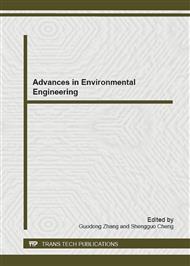[1]
Ye J, Singh A, Ward OP, "Biodegradation of nitroaromatics and other nitrogen-containing xenbiotics," World J Microbiol Biotech,Vol.20 (2004), p.117.
Google Scholar
[2]
He ZQ, Spain JC, "Studies of the catabolic pathway of degradation of nitrobenzene by Pseudomonas pseudoalcaligenes JS45: removal of the amino group from 2-aminomuconic semialdehyde," Appl Environ Microbiol,Vol. 63 (1997), p.4839.
DOI: 10.1128/aem.63.12.4839-4843.1997
Google Scholar
[3]
Zheng CL, Zhou JT, Zhao LH, Lu H, Qu BC, Wang J , "Isolation and characterization of a nitrobenzene degrading Streptomyces strain from activated sludge,"Bull Evniron Contam Toxicol,Vol. 78 (2007), p.163.
DOI: 10.1007/s00128-007-9031-z
Google Scholar
[4]
Wei CH, Hou Y, Ren Y, Xie B, Wu CF, "Bio-cooperation effect and mixing substrates in the aerobic degradation of nitrobenzene,." China Environmental Science, Vol.20 (2000), p.241 (in Chinese).
Google Scholar
[5]
Nishino SF, Spain JC , "Oxidative pathway for the biodegradation of nitrobenzene by Comamonas sp. Strain JS 765," Appl Environ Microbiol,Vol. 61 (1995), p.2308.
DOI: 10.1128/aem.61.6.2308-2313.1995
Google Scholar
[6]
Liu HG, Zheng H, Sun GP, Wang SJ, Lai LH "The isolation, characterization of nitrobenzene degrading strains.'"Environmental Science and Technology ,Vol.1 (1991), p.16 (in Chinese).
Google Scholar
[7]
Davis EM, Murray HE, Liehr JG, "Powers EL Basic microbial degradation rates and chemical byproducts of selected organic compounds," Water Res,vol. 15 (1981), p.1125.
DOI: 10.1016/0043-1354(81)90082-8
Google Scholar
[8]
Levin L, Viale A, "Forchiassin A Degradation of organic pollutants by the white rot basidiomycete Trametes trogii," International Biodeterioration & Biodegradation, Vol.52 (2003), p.1.
DOI: 10.1016/s0964-8305(02)00091-4
Google Scholar
[9]
Zheng CL, Zhou JT, Wang J, Wang J, Qu BC , "Isolation and characterization of a nitrobenzene degrading yeast strain from activated sludge," J Hazard Mater,Vol. 160 (2008), p.194.
Google Scholar
[10]
Zheng CL, Qu BC, Wang J, Zhou JT, Wang J, Lu H, "Isolation and characterization of a novel nitrobenzene-degrading bacterium with high salinity tolerance," Micrococcus leteus. J Hazard Mater, Vol.165 (2009 I),p.1152.
DOI: 10.1016/j.jhazmat.2008.10.119
Google Scholar
[11]
Woolard CR, Irvine RL, "Treatment of hypersaline wastewater in the sequencing batch reactor," Water Res, Vol.29 (1995), p.1159.
DOI: 10.1016/0043-1354(94)00239-4
Google Scholar
[12]
Karigar C, Mahesh A, Nagenahalli M et al , "Phenol degradation by immobilized cells of Arthrobacter citreus," Biodegradation, Vol. 17 (2006), p.47.
DOI: 10.1007/s10532-005-3048-y
Google Scholar
[13]
Lu CJ, Lee CM, Huang CZ, "Biodegradation of chlorophenols by immobilized pure-culture microorganisms," Water Sci Technol, Vol.34 (1996), p.67.
Google Scholar
[14]
Wang JL, Quan QX, Han LP et al, "Microbial degradation of quinoline by immobilized cells of Burkholderia pickett," Water Res, Vol. 36 (2002), p.2288.
Google Scholar
[15]
Lee ST, Rhee SK, Lee GM , "Biodegradation of pyridine by freely and suspended immobilized Pimelobacter sp," Appl Microbiol Biotechnol, Vol.41 (1994), p.652.
DOI: 10.1007/bf00167280
Google Scholar
[16]
Manohar S, Karegoudar TB, "Degradation of naphthalene by cells of Pseudomonas sp. strain NGK 1 immobilized in alginate, agar and polyacrylamide," Appl Microbiol Biotechnol, Vol.49 (1998), p.785.
DOI: 10.1007/s002530051247
Google Scholar
[17]
Oh YS, Maeng J, Kim SJ , "Use of microorganism-immobilized polyurethane foams to absorb and degraded oil on water surface," Appl Microbiol Biotechnol, Vol.54 (2000), p.418.
DOI: 10.1007/s002530000384
Google Scholar
[18]
Oreilly KT, Crawford RL , "Degradation of pentachlorophenol by polyurethane-immobilized Flavobacterium cells," Appl Environ Microbiol, Vol. 55 (1989), p.213.
DOI: 10.1128/aem.55.9.2113-2118.1989
Google Scholar
[19]
Wang J, Yang H, Lu H, Zhou JT, Wang J, Zheng CL, "Aerobic degradation of nitrobenzene by a defined microbial consortium immobilization in polyurethane foam," World J Microbiol Biotechnol, Vol. 25 (2009), p.875.
DOI: 10.1007/s11274-009-9962-0
Google Scholar
[20]
Zheng CL, Zhou JT, Wang J, Qu BC, Lu H, Zhao HX, "Aerobic degradation of nitrobenzene by immobilization of Rhodotorula mucilaginosa in polyurethane foam," J Hazard Mater, Vol. 168 (2009 II), p.298.
DOI: 10.1016/j.jhazmat.2009.02.029
Google Scholar
[21]
Andrews JF, "A mathematical model for the continuous culture of microorganisms utilizing inhibitory substrates," Biotechnol Bioeng, Vol. 10 (1968), p.707.
Google Scholar


